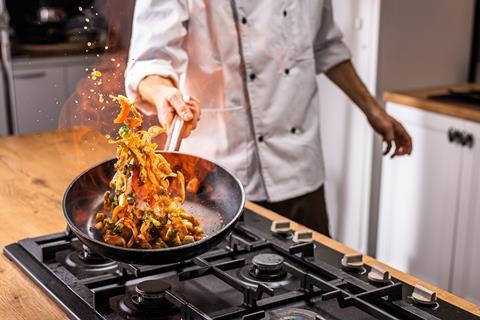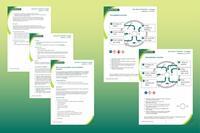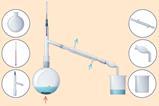Observation is a key skill for budding chemists. This is how to develop it with your younger students

Serendipity, or happy misfortune, has a long and interesting history in the world of chemical discoveries. Roy Plunkett, at the American chemical giant DuPont, was researching non-toxic replacements for refrigerant gases. Ammonia and sulfur dioxide were commonly used at the time, but are highly toxic and led to many tragic accidents. Roy made tetrafluoroethene (C2 F4) and stored it in cylinders. When Roy opened one of the cylinders he found no gas, but rather a white waxy solid. Instead of disposing of the cylinder, Roy investigated the substance, observing its extreme slipperiness. This attention to detail and curiosity led to the development of Teflon, with worldwide sales of $1.3 billion in 2019.
What students need to know
- Observation is a fundamental technique for scientists.
- Records of observations should be made immediately in appropriate formats, including tables.
- Drawing inferences from observations allows scientists to explain something about the world.
- Good observations allow interesting questions to be asked, leading to further enquiry.
Ideas for the classroom
Accurate observation is not an innate skill for most students. It can be useful for students to carry out specific tasks focused on developing these skills, rather than just assuming they will develop through exposure. As noted in the Gatsby Getting Practical project, planning for more than three or four learning outcomes from a practical tends to lead to student overload and poorer outcomes.
Many simple practical tasks can be used to provide interesting observations and, most importantly, observations that aren’t necessarily immediately obvious. Explain to your students that some of the reactions take some time to occur, so they will need to be patient and focused – they should resist the temptation of off-task chatting while the reaction is occurring as they’ll likely miss the changes!
-

Download this microscale practical
Hone your students’ observation skills by asking them to observe two microscale reactions: neutralising citric acid and creating a lead iodide precipitate. Students will observe the dissolution of the crystals, colour change of the indicator and formation of the product. Download the teacher and technician notes as MS Word or pdf and the student integrated instructions as MS Word or pdf.
Download this
A microscale practical to hone your students’ observation skills by observing two reactions from the EiC website: rsc.li/LINK
Small and microscale chemistry practicals provide plenty of variety that can be used in this way. Some of my favourites involve mixing chemicals in small drops of water. This can be done on a laminated instruction sheet (if it is going to be used multiple times), or on a plastic wallet. For example, rather than mixing potassium iodide solution with lead nitrate solution in a test tube, try the reaction with crystals of the solid pushed into either side of the drop of water. Observations include ‘the crystals disappear’, ‘yellow shiny crystals appear’ and ‘more crystals appear over time’. From these observations, encourage your students to make inferences on what is happening at the sub-microscopic level as the solid dissolves, the ions diffuse, and a new insoluble substance is produced.

Similarly, have the students push crystals of sodium carbonate and citric acid into a drop containing universal indicator. This forms a microscale version of the demonstration favourite Rainbow fizz. The carbon dioxide bubbles take time to develop, and close observation and patience are again important.
Comparing the relative reactivity of metals is commonly carried out by adding samples into test tubes of hydrochloric acid. Magnesium reacts immediately and students’ eyes are naturally drawn to this reaction. In comparison, the reaction with zinc is much slower, following the reactivity series, and students often dismiss this as ‘there’s nothing happening’. Encourage patience again – have them watch the tubes carefully for a full minute and they’ll start to see the bubbles forming. When you discuss their inferences, ask them how they would modify the practical to make their observations easier to make. Most will come up with the idea of heating the acid. Have some beakers and kettles to hand to let them carry this out straight away. This will give them a taste of the cyclic nature of scientific discovery from observation to hypothesis, to prediction, to experiment and back to observation.
If students are struggling with unfamiliar contexts like neutralisation, try using an everyday reaction like burning a candle – there are many observations to make here. The Simple chemical reactions: how do candles work? practical demonstration and activity are designed to explore what happens when a candle burns with younger students.
If students are struggling with unfamiliar contexts like neutralisation, try using an everyday reaction like burning a candle – there are many observations to make here. The Simple chemical reactions: how do candles work? practical demonstration and activity (rsc.li/LINK) are designed to explore what happens when a candle burns with younger students.
Common misconceptions
A common difficulty for students is caused by a lack of patience, care and attention when it comes to making observations. Many advances in scientific theory, such as disproving the theory of phlogiston, have come from paying attention to marginal observations that could have been dismissed as due to random error.

Students can also struggle to unpick the difference between an observation and the inference, or the meaning of that observation. This lack of clarity can be seen later on in their education when their answers to ‘Describe’ and ‘Explain’ questions look very similar. Have a look at the The nature of science: Black box resource for simple ways to support students in linking observation and theory. Naomi Hennah also has some further tips in her article Help students connect observations to theory.
Students can also struggle to unpick the difference between an observation and the inference, or the meaning of that observation. This lack of clarity can be seen later on in their education when their answers to ‘Describe’ and ‘Explain’ questions look very similar. Have a look at the The nature of science: Black box resource (rsc.li/LINK) for simple ways to support students in linking observation and theory. Naomi Hennah also has some further tips in her article ’Help students connect observations to theory’ (rsc.li/LINK).
Finally, students will often attribute the observed properties of materials to the sub-microscopic particles. For example, a piece of copper is shiny, therefore copper atoms are shiny. Discussing the different ways we talk about chemistry can help, although be prepared for many conversations over the years as students learn to ‘see’ chemistry in the abstract.
Formative assessment
Listen to your students talking to each other about their observations and inferences during practical work. Are they making accurate observations and using correct terminology? Are they spotting all that is going on in a reaction, or just the most obvious parts? You can use concept cartoons, such as What happens during neutralisation?, to help them voice their thinking.
Listen to your students talking to each other about their observations and inferences during practical work. Are they making accurate observations and using correct terminology? Are they spotting all that is going on in a reaction, or just the most obvious parts? You can use concept cartoons, such as What happens during neutralisation? (rsc.li/LINK), to help them voice their thinking.
Progression to 14–16
Measurement is also important at 11–14. During their chemistry studies, students will apply their observation and measurement skills in a variety of contexts. They will plan their own experiments to make observations, test hypotheses and explore phenomena. They will be expected to be accurate in making measurements and select appropriate equipment. Evaluation of practical skills is also important in their scientific apprenticeship.
Take-home points
- Careful observation skills can be developed within a rich variety of practical work.
- Students should be careful to distinguish between their observations and the inferences they then draw.
- Make use of tasks that are simple for students to carry out but that can provide multiple observations.
- Students will continue to develop these skills over the course of their chemistry education.














No comments yet